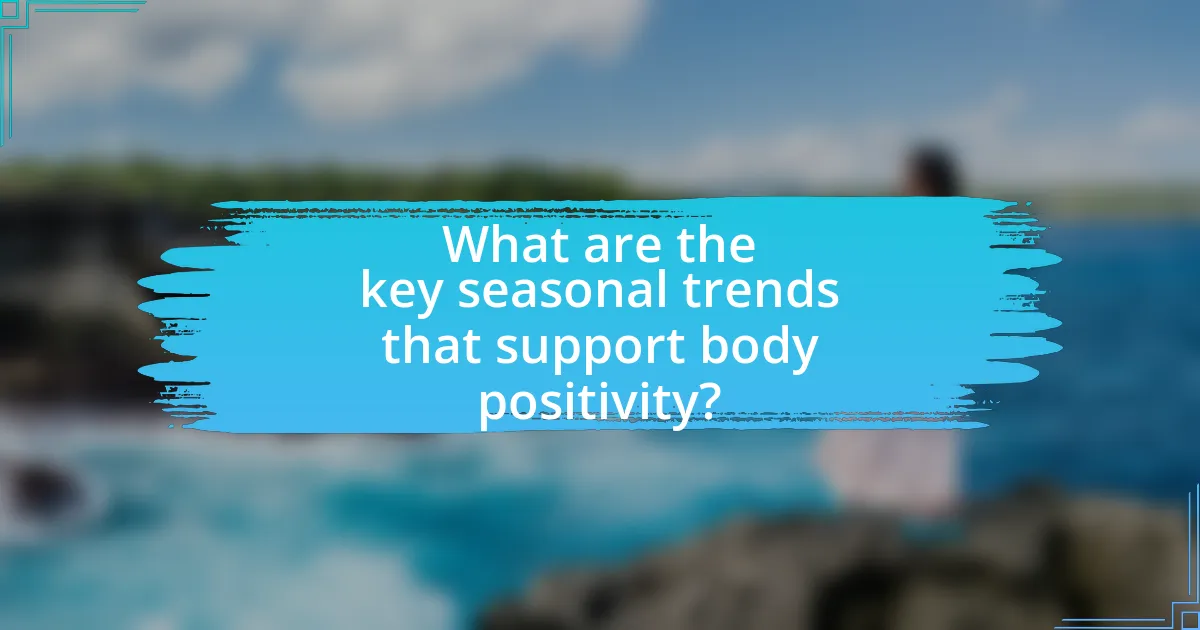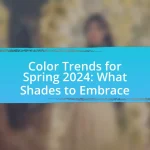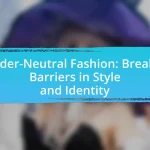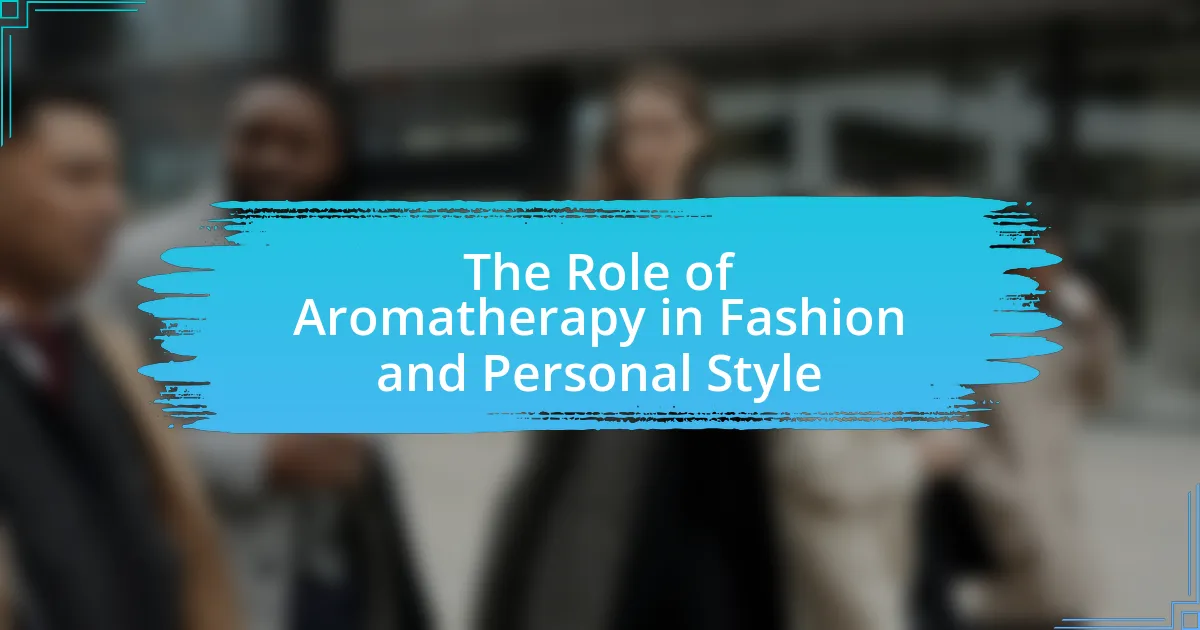Seasonal fashion trends that promote body positivity focus on inclusive sizing, diverse representation in advertising, and the use of comfortable fabrics. These trends encourage self-acceptance and confidence by ensuring that individuals of all body types can find fashionable options that fit well. The article explores how these trends influence body image, the importance of inclusivity in fashion, and the societal implications of promoting body positivity. Additionally, it highlights practical tips for incorporating body-positive fashion into personal wardrobes, including selecting flattering styles, utilizing layering techniques, and choosing accessories that enhance confidence.

What are Seasonal Fashion Trends That Promote Body Positivity?
Seasonal fashion trends that promote body positivity include inclusive sizing, diverse representation in advertising, and the use of comfortable, flattering fabrics. Inclusive sizing allows individuals of all body types to find fashionable options that fit well, which is essential for fostering self-acceptance. Diverse representation in advertising campaigns showcases models of various shapes, sizes, and ethnicities, reinforcing the message that beauty is not one-dimensional. Additionally, the use of comfortable fabrics, such as stretchable materials and breathable textiles, enhances wearability and encourages individuals to embrace their bodies. These trends collectively contribute to a more positive body image in the fashion industry.
How do seasonal fashion trends influence body positivity?
Seasonal fashion trends influence body positivity by promoting diverse body representations and encouraging self-acceptance through inclusive styles. For instance, trends that embrace various body shapes and sizes, such as oversized clothing or adjustable fits, help individuals feel more comfortable and confident in their own skin. Research indicates that fashion brands that showcase models of different sizes and backgrounds can positively impact consumers’ self-esteem and body image, as seen in campaigns by brands like Aerie and Savage X Fenty, which have reported increased customer engagement and satisfaction. This shift towards inclusivity in seasonal trends fosters a culture of acceptance, allowing individuals to celebrate their bodies regardless of societal standards.
What role does inclusivity play in seasonal fashion trends?
Inclusivity plays a crucial role in seasonal fashion trends by ensuring that diverse body types, sizes, and identities are represented in clothing lines. This representation not only broadens the market appeal but also fosters a sense of belonging among consumers, as brands that embrace inclusivity often see increased customer loyalty and engagement. For instance, a study by the Fashion Institute of Technology found that brands promoting body positivity and inclusivity experienced a 30% increase in sales, demonstrating the financial benefits of catering to a wider audience.
How can seasonal trends cater to diverse body types?
Seasonal trends can cater to diverse body types by offering a variety of styles, cuts, and fabrics that enhance individual shapes and sizes. For instance, spring collections often feature flowy silhouettes and breathable materials that accommodate curvier figures, while fall trends may include structured outerwear that flatters athletic builds. Research indicates that inclusive sizing and diverse representation in fashion can lead to increased body positivity, as seen in brands that showcase models of various body types in their seasonal campaigns. This approach not only promotes self-acceptance but also encourages consumers to embrace their unique body shapes through tailored seasonal offerings.
Why is body positivity important in fashion?
Body positivity is important in fashion because it promotes inclusivity and self-acceptance among diverse body types. This movement challenges traditional beauty standards that often marginalize individuals who do not fit a narrow definition of attractiveness. Research indicates that body positivity can lead to improved mental health outcomes, as it encourages individuals to embrace their unique bodies, reducing feelings of inadequacy and promoting overall well-being. For instance, a study published in the journal “Body Image” found that individuals exposed to body-positive messages reported higher self-esteem and body satisfaction. By integrating body positivity into fashion, brands can foster a more accepting environment that empowers consumers and reflects the diversity of real bodies.
How does body positivity impact self-esteem and confidence?
Body positivity significantly enhances self-esteem and confidence by promoting acceptance of diverse body types and challenging societal beauty standards. Research indicates that individuals who embrace body positivity experience improved mental health outcomes, including reduced anxiety and depression, which directly correlates with higher self-esteem levels. A study published in the journal “Body Image” by Tiggermann and Slater (2014) found that exposure to body-positive media led to increased body satisfaction among participants, reinforcing the idea that positive body image fosters greater self-confidence.
What are the societal implications of promoting body positivity in fashion?
Promoting body positivity in fashion leads to increased inclusivity and diversity within the industry. This shift encourages brands to represent a wider range of body types, which can positively impact self-esteem and body image among consumers. Research indicates that exposure to diverse body representations can reduce body dissatisfaction; for instance, a study published in the journal “Body Image” found that individuals exposed to images of diverse body types reported higher body satisfaction levels. Furthermore, this movement challenges traditional beauty standards, fostering a culture that values individuality over conformity, which can contribute to broader societal acceptance of different body shapes and sizes.

What are the key seasonal trends that support body positivity?
Key seasonal trends that support body positivity include inclusive sizing, diverse representation in marketing, and the promotion of comfort over conformity. Inclusive sizing ensures that clothing is available for a wide range of body types, allowing individuals to find styles that fit and flatter them. Diverse representation in marketing campaigns showcases models of various shapes, sizes, and backgrounds, fostering a sense of belonging and acceptance among consumers. Additionally, the trend towards comfort, particularly in athleisure and relaxed fits, encourages individuals to prioritize their well-being and self-expression over societal beauty standards. These trends collectively contribute to a culture that celebrates all bodies, reinforcing the message that beauty is not confined to a specific ideal.
How do colors and patterns contribute to body positivity in fashion?
Colors and patterns significantly contribute to body positivity in fashion by enhancing self-expression and promoting inclusivity. Vibrant colors can evoke positive emotions and boost confidence, while diverse patterns can flatter various body shapes, allowing individuals to embrace their unique features. Research indicates that wearing colors associated with positivity, such as bright hues, can lead to improved self-esteem and body image. Additionally, patterns like stripes or florals can create visual interest and draw attention to areas that individuals feel confident about, further reinforcing a positive self-image.
What color palettes are trending this season for body positivity?
This season, trending color palettes for body positivity include warm earth tones, vibrant jewel tones, and soft pastels. Warm earth tones, such as terracotta and olive green, promote a sense of comfort and inclusivity, aligning with the body positivity movement’s focus on self-acceptance. Vibrant jewel tones like emerald green and royal blue are also popular, as they evoke confidence and empowerment. Additionally, soft pastels, including lavender and blush pink, create a calming effect, encouraging individuals to embrace their unique beauty. These color choices reflect a broader cultural shift towards celebrating diverse body types and fostering a positive self-image.
How do patterns enhance body confidence in clothing?
Patterns enhance body confidence in clothing by creating visual interest and drawing attention away from perceived flaws. When individuals wear patterned clothing, the complexity of the design can distract the eye, allowing for a more balanced perception of body shape. Research indicates that wearing bold patterns can lead to increased self-esteem, as individuals often feel more expressive and unique in their attire. A study published in the Journal of Fashion Marketing and Management found that individuals who wore patterns reported feeling more confident and positive about their body image compared to those in solid colors. This suggests that patterns not only serve an aesthetic purpose but also play a significant role in promoting body positivity.
What types of clothing styles are popular for promoting body positivity?
Clothing styles that are popular for promoting body positivity include oversized garments, high-waisted bottoms, and inclusive sizing options. Oversized garments, such as baggy sweaters and loose-fitting dresses, provide comfort and allow individuals to express their style without focusing on body shape. High-waisted bottoms, like jeans and skirts, enhance body proportions and offer support, making them a favored choice among diverse body types. Additionally, brands that offer inclusive sizing ensure that all individuals can find fashionable options that fit well, reinforcing the message that beauty comes in all shapes and sizes. This trend aligns with the growing movement towards body positivity, which emphasizes self-acceptance and confidence in one’s own skin.
Which silhouettes are most flattering for various body shapes?
A-line silhouettes are most flattering for various body shapes, as they create a balanced look by accentuating the waist while allowing for movement around the hips. For pear-shaped bodies, A-line dresses and skirts help to draw attention to the waist and provide a flattering fit over the hips. Hourglass figures benefit from fitted silhouettes that highlight curves, such as wrap dresses, which emphasize the waist and enhance the overall shape. For apple-shaped bodies, empire waistlines are effective, as they provide support under the bust and flow over the midsection, creating a streamlined appearance. Rectangular body shapes can opt for peplum tops or dresses that add volume at the hips, creating the illusion of curves. These recommendations are supported by fashion experts who emphasize the importance of silhouette in enhancing body positivity and confidence in personal style.
How do layering techniques support body positivity?
Layering techniques support body positivity by allowing individuals to express their personal style while accommodating diverse body shapes and sizes. These techniques enable people to create outfits that enhance their confidence, as they can mix and match various pieces to highlight their favorite features and downplay areas they may feel less comfortable about. For instance, studies show that clothing choices significantly impact self-esteem; layering can provide a sense of control over one’s appearance, fostering a positive body image. Additionally, the versatility of layering encourages inclusivity in fashion, as it offers options for all body types, promoting the idea that beauty comes in many forms.

How can individuals incorporate body-positive fashion trends into their wardrobe?
Individuals can incorporate body-positive fashion trends into their wardrobe by selecting clothing that emphasizes comfort, fit, and personal expression. This includes choosing styles that celebrate diverse body shapes, such as high-waisted pants, wrap dresses, and oversized tops, which are designed to flatter various figures. Additionally, individuals can opt for brands that prioritize inclusivity and offer a wide range of sizes, ensuring that fashion is accessible to everyone. Research indicates that wearing clothing that aligns with body-positive values can enhance self-esteem and body image, as noted in studies published in the Journal of Fashion Marketing and Management.
What are some practical tips for selecting body-positive clothing?
To select body-positive clothing, prioritize fit and comfort by choosing garments that flatter your unique shape rather than conforming to traditional sizing standards. Look for styles that offer stretch, adjustable features, and inclusive sizing options, as these elements enhance comfort and confidence. Additionally, consider fabrics that are breathable and soft against the skin, which can improve overall wearability. Research indicates that wearing clothing that fits well and feels good can significantly boost self-esteem and body image, reinforcing the importance of selecting pieces that celebrate individual body diversity.
How can one choose the right fit for their body type?
To choose the right fit for a body type, individuals should first identify their specific body shape, such as pear, apple, hourglass, or rectangle. Understanding one’s body shape allows for selecting clothing that enhances natural proportions. For example, pear-shaped individuals may benefit from A-line dresses that accentuate the waist while providing room for the hips. Research indicates that wearing clothes that fit well can improve self-esteem and body image, as supported by a study published in the Journal of Fashion Marketing and Management, which found that well-fitting clothing positively influences how individuals perceive their bodies. Therefore, selecting styles that align with body shape not only enhances appearance but also promotes body positivity.
What accessories can enhance body-positive outfits?
Accessories that can enhance body-positive outfits include statement belts, oversized scarves, bold jewelry, and comfortable footwear. Statement belts can define the waist and add structure to various silhouettes, promoting a flattering look. Oversized scarves not only provide warmth but also create visual interest and can be styled in multiple ways to suit different body types. Bold jewelry, such as large earrings or chunky necklaces, draws attention and adds personality to outfits, encouraging self-expression. Comfortable footwear, like stylish sneakers or supportive sandals, ensures that individuals feel confident and at ease, which is essential for body positivity. These accessories collectively contribute to a more inclusive and empowering fashion experience.
What resources are available for staying updated on body-positive fashion trends?
To stay updated on body-positive fashion trends, individuals can utilize various resources such as fashion blogs, social media platforms, and online communities dedicated to body positivity. Notable fashion blogs like “The Curvy Fashionista” and “GabiFresh” provide insights and updates on inclusive fashion. Social media platforms, particularly Instagram and TikTok, feature influencers and brands that promote body positivity, allowing users to follow hashtags like #BodyPositiveFashion for real-time updates. Additionally, online communities such as Facebook groups and forums focused on body positivity foster discussions and share the latest trends, making them valuable resources for staying informed.
Which influencers and brands focus on body positivity in fashion?
Influencers and brands that focus on body positivity in fashion include Ashley Graham, Tess Holliday, and brands like Aerie and Savage X Fenty. Ashley Graham is a prominent model and advocate for body positivity, known for her work in promoting inclusivity in the fashion industry. Tess Holliday, another influential figure, has been a vocal supporter of body diversity and representation. Aerie, a lingerie and apparel brand, has gained recognition for its #AerieREAL campaign, which promotes unretouched images of models of various body types. Savage X Fenty, founded by Rihanna, is celebrated for its diverse range of sizes and its commitment to showcasing models of all shapes and backgrounds in its fashion shows. These influencers and brands collectively contribute to a growing movement that challenges traditional beauty standards and promotes acceptance of all body types.
How can social media platforms be used to discover body-positive trends?
Social media platforms can be used to discover body-positive trends by leveraging hashtags, following influencers, and engaging with communities that promote body positivity. Hashtags like #BodyPositivity and #EffYourBeautyStandards allow users to find content that celebrates diverse body types, while influencers who advocate for body acceptance often share personal stories and fashion choices that resonate with their followers. Additionally, platforms like Instagram and TikTok feature algorithms that promote content based on user engagement, making it easier to discover emerging trends in body positivity as they gain traction. Research indicates that social media significantly influences body image perceptions, with a study published in the journal “Body Image” showing that exposure to body-positive content can improve self-esteem and body satisfaction among users.
What are the best practices for embracing body positivity through fashion?
The best practices for embracing body positivity through fashion include selecting clothing that fits well and flatters individual body shapes, promoting inclusivity by supporting brands that offer diverse sizing, and prioritizing comfort alongside style. Wearing outfits that reflect personal style and confidence can enhance self-esteem, while choosing fabrics and cuts that allow for ease of movement contributes to a positive body image. Supporting brands that advocate for body positivity and showcase models of various sizes reinforces the message of acceptance and diversity in fashion. Research indicates that positive body image can lead to improved mental health outcomes, highlighting the importance of these practices in fostering a supportive fashion environment.

















